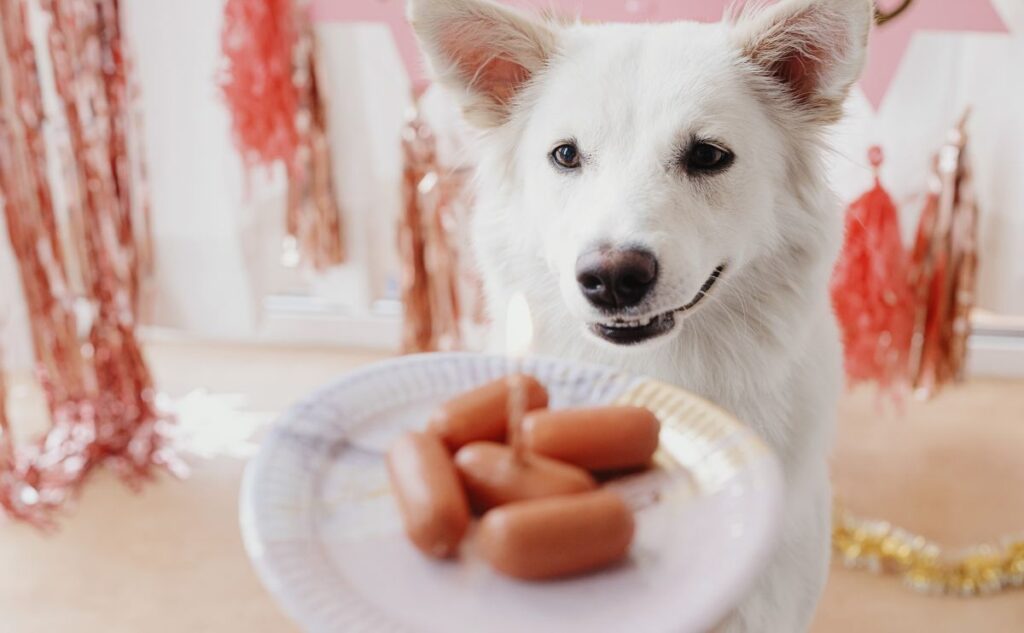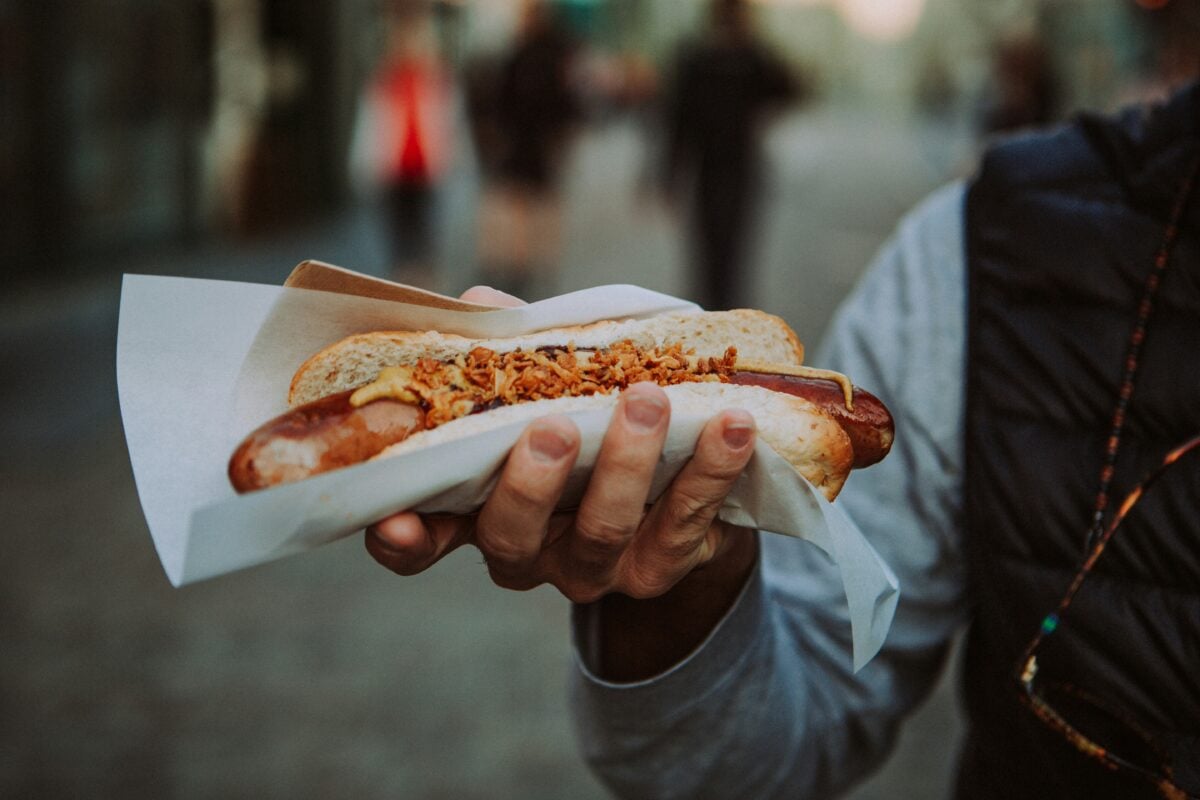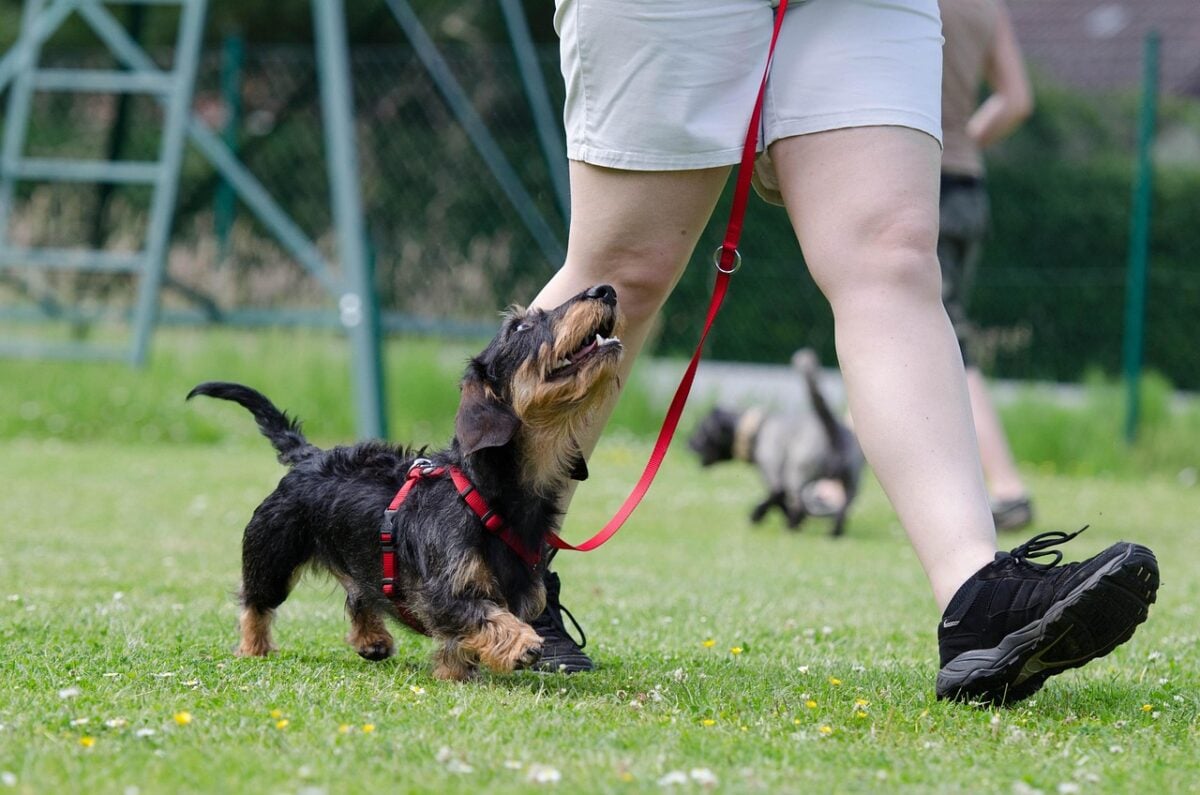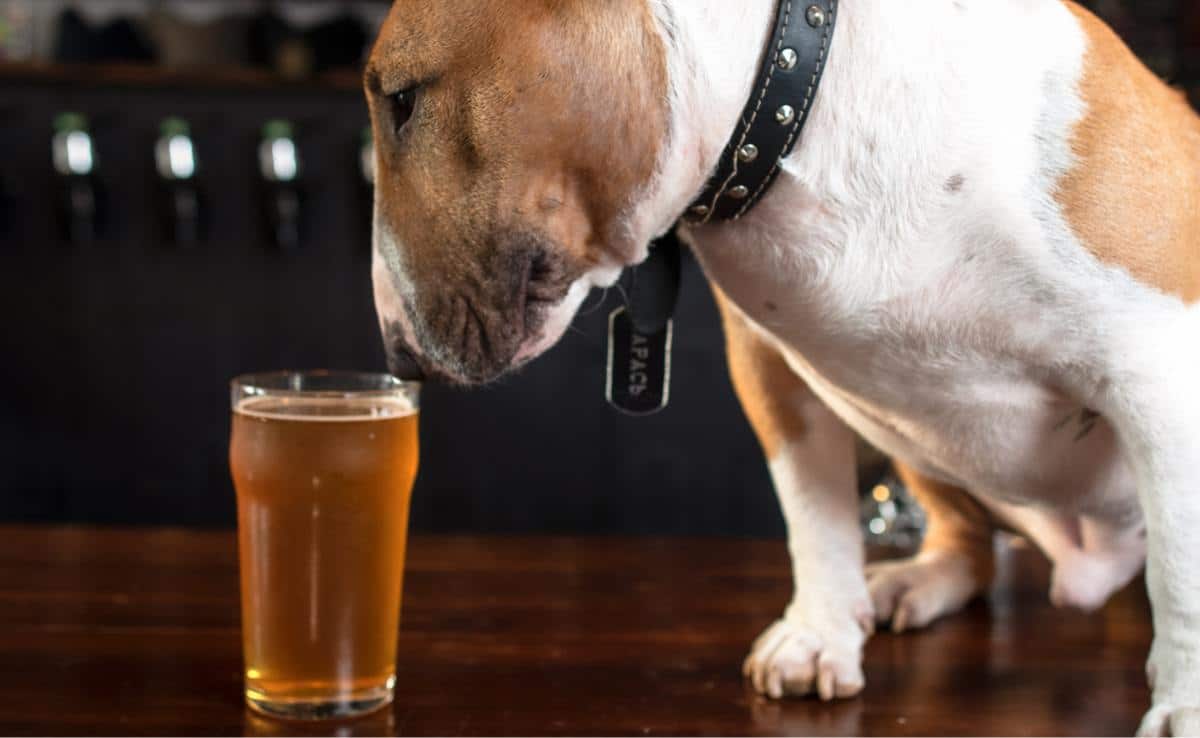Your Dog Is Not Joey Chestnut: Can Dogs Eat Hot Dogs Or Should They Sit This One Out?
When you purchase through links on our site, we may earn a commission. Here’s how it works.
Every summer, we gather around grills, crowd into ballparks, and tune into our TVs for frankfurter-fueled fun. But what happens when your dog starts eyeing that sizzling sausage on your plate like they’ve entered the Nathan’s Famous Hot Dog Eating Contest?
Table of Contents
Before you toss your pup a bite of that ballpark classic, it’s worth asking: Can dogs actually eat hot dogs safely? And if so, should they?
So … Can Dogs Eat Hot Dogs Or Not?
Short answer? Kind of.

A bite here and there probably won’t hurt your dog, but that doesn’t mean it’s safe, smart, or something vets recommend.
Long answer? It depends on what’s inside, how much they eat, and their stomach’s sensitivity.
Some ingredients are toxic. Others just pack way more salt and fat than your pup should handle.
And the risk? It’s more than just an upset tummy.
So before you toss them a chunk from the grill, ask yourself:
- What’s really in that hot dog?
- Could it be a choking hazard?
- Would I feed this to a puppy?
We’ll break all of that down next.
What’s Actually In A Hot Dog? (And What Should Worry You Most)
Hot dogs are not just meat. They are a mix of by-products, fat, sodium, flavorings, and preservatives, formed into a tube and sold as food.

That might fly at a backyard BBQ, but your dog’s body is not built for this kind of ultra-processed snack.
Some ingredients are known hazards. Others just add to the risk when eaten regularly.
Common Red Flags For Dogs
- Garlic and onion powder – Even a little can be toxic
- Sodium nitrate and nitrite – Linked to digestive issues and long-term illness
- Artificial smoke flavoring – Hard on the stomach and unnecessary
- High sodium – One hot dog can contain more salt than a small dog should have in a full day
Processed hot dogs may be labeled based on the primary meat source they include, for example, pork. However, they may contain other meats.
That makes it harder to avoid allergens or identify what upsets your dog’s stomach. If your pup has food sensitivities, hot dogs are not worth the risk.
Quick Tip: If your dog has allergies or a sensitive gut, skip hot dogs entirely. The ingredient list alone makes them unpredictable.
Wait—Hot Dogs Are A Group 1 Carcinogen?
This part surprises a lot of people.
The World Health Organization classifies processed meats, such as hot dogs and frankfurters, as Group 1 carcinogens. That means there’s strong evidence they can cause cancer, just like tobacco and asbestos.
In humans, eating too much processed meat has been linked to higher risks of bowel and stomach cancer. While research on dogs is limited, their digestive systems are more sensitive than those of humans.
So even if the label says “natural” or “uncured,” it’s still processed. And it is still best to keep it off your dog’s menu, especially if you want to reduce their long-term cancer risk.
What About Plant-Based Hot Dogs?
Some dog owners assume vegetarian hot dogs are safer. After all, they are meat-free and often lower in fat.
But that does not mean they are a good treat for dogs. Plant-based hot dogs can still contain garlic, onion, added oils, spices, and artificial flavors. They are also highly processed.
Unless you have read every ingredient and confirmed it is safe for dogs, plant-based hot dogs belong in the “not worth it” category, too.
Would You Feed It To A Puppy? Then Don’t Feed It To Your Dog Either
Puppies are extra sensitive. Their digestive systems are still developing, and their small size means that even a small amount of salt or fat can cause a significant reaction.

That’s why hot dogs are a hard no for puppies. The risk of stomach upset, vomiting, diarrhea, or even pancreatitis just isn’t worth it.
But here’s the thing: most adult dogs are not much better off. If your pup has a sensitive stomach, food allergies, or any history of pancreatitis, even a small piece of hot dog can backfire.
Quick Check: If you wouldn’t feed it to a growing puppy, it probably isn’t the best choice for your adult dog either.
There are plenty of safe treats out there. Hot dogs just aren’t one of them.
The Choking Risk Most Pet Parents Overlook
Hot dogs might be soft, but they can still be a danger, especially for small dogs.
When a dog gulps a chunk of hot dog without chewing, it can easily become lodged in their throat. That is especially true for round, coin-shaped pieces, which can block the airway almost instantly.
Even large dogs can choke if they are excited or distracted. It happens more often than you might expect.
Pro Tip: If you must give a bite of hot dog, always cut it into long, skinny strips. Avoid round slices, which are more likely to get stuck.
This is not just a puppy problem. Adult dogs can choke on hot dogs, too, especially when begging at a cookout or grabbing food off the ground.
Raw, Burned, Or Just Bad Timing: When A Hot Dog Becomes Extra Risky
Most store-bought hot dogs are labeled “fully cooked,” but that does not mean they are safe to eat raw, especially for dogs.
Hot dogs can carry harmful bacteria, such as Listeria or Salmonella. For humans, the risk is low. Dogs are more vulnerable, especially if they are older, very young, or have a weakened immune system.
If your dog is on a raw food diet, hot dogs should not be part of it. They contain multiple meat sources and preservatives that do not belong in a raw feeding plan.

On the opposite end of the spectrum, hot dogs get extremely hot on the grill. If your dog grabs one straight off the barbecue or if you offer it too soon, it could burn their mouth, throat, or stomach.
Let hot dogs cool completely before offering a bite. And even then, ensure it is a small, soft piece that poses no risk.
Quick Test: Before feeding any cooked meat, cut it in half to ensure it is thoroughly cooked. If you cannot hold your finger on the inside for a few seconds, it is too hot for your dog to eat.
Hot Dogs As Treats? Here’s When It Might Be OK
Most vets agree that hot dogs are not ideal for dogs. However, if you are in a pinch and your dog has no known health issues, a tiny piece occasionally probably will not cause harm.
The key is moderation. Think of hot dogs the same way you would think of fast food—something that is fine once in a while, but not something to serve regularly.
If you do give your dog a bite, choose hot dogs with fewer ingredients and no garlic, onion, or artificial flavorings. Uncured and lower-fat options are safer than the average ballpark frank.
Quick Rule: If the ingredients list is longer than your dog’s leash, skip it.
Some people use hot dogs for training rewards, especially in high-distraction environments. In that case, cut the pieces as small as possible and limit the total amount. You want your dog to be motivated, not bloated.
If your dog has a sensitive stomach or a history of pancreatitis, it is best to avoid hot dogs entirely.
Our Personal Experience
We don’t cook hot dogs all that often at my house (3 or 4 times a year), but when we do, it’s basically my dog Falkor’s version of the Super Bowl. The moment that unmistakable meaty aroma drifts through the air, he materializes at my feet like a fluffy little shadow, eyes wide, tail wagging, radiating pure hope.
He gives me the look, that irresistible, head-tilted, “Hey, best friend, how about sharing?” expression that could probably win awards. I know hot dogs aren’t exactly healthy food, for dogs or humans, but what can I say? I’m a softie for a cute face and puppy dog eyes.
So, I cave, breaking off a tiny piece for him. It’s just enough to make his day, send his tail into overdrive without throwing his diet (or mine) completely off the rails.
Most days, though, I stick to boiled chicken when I want to spoil him. It’s his second-favorite treat, maybe not as thrilling as a sizzling hot dog, but still enough to earn me those same adoring eyes, without the guilt.
– Danielle DeGroot, Hot Dog Negotiator-in-Chief & Writer for Canine Journal
Choosing The Least-Worst Hot Dog
If you are determined to share, here is what to look for:
- Fewer than 5 ingredients
- Labeled “no added nitrates or nitrites”
- No garlic, onion, or seasoning blends
- Lower in fat and calories than average
- Made from a single meat source
Still, hot dogs should never become your dog’s go-to treat. Better options are just a scroll away.
Safer Snacks To Share Instead
You don’t have to give up the joy of treating your dog during a cookout. You just need better options.
Here are some safe, vet-approved alternatives that dogs love.
- Freeze-dried meat teats: Single-ingredient treats, such as freeze-dried chicken or beef liver, are protein-packed and gentle on sensitive stomachs.
- Sliced carrots or cucumbers: Crunchy, low-calorie, and full of fiber. They also help clean teeth a bit while your dog chews.
- Dog-safe jerky: Look for jerky explicitly made for dogs, with no added salt, smoke flavor, or preservatives.
- Cooked sweet potato slices: Baked or dehydrated sweet potatoes make a chewy, naturally sweet treat that most dogs enjoy.
- Fresh watermelon (no seeds): Hydrating and refreshing, especially on hot days. Just avoid the rind and seeds.
- Plain Cooked Chicken: If you’re grilling, set aside a small piece of plain, skinless chicken before adding the seasonings.
Pro Tip: Keep a few of these treats on hand during BBQs so your dog is not tempted to beg for something that could hurt them.
Side Effects Of Sharing That Sausage
Even if your dog seems fine after a bite of hot dog, there could be problems brewing behind the scenes. Hot dogs are rich, salty, and highly processed, which makes them hard on your dog’s digestive system.

Here are the most common side effects to watch for:
1. Digestive Upset
Vomiting, diarrhea, bloating, and gas are common reactions when dogs eat something their body is not used to. Processed meats can disrupt the balance of gut bacteria and lead to inflammation.
2. Weight Gain
A single hot dog can contain up to 300 calories. That is a full day’s worth of food for many small dogs. Regular high-calorie treats can add up quickly and increase the risk of obesity.
3. Pancreatitis Risk
Fatty meats can trigger pancreatitis, especially in dogs who are already prone to it. This condition is painful, dangerous, and often requires emergency vet care.
4. Long-Term Health Concerns
Feeding processed meat regularly may increase your dog’s risk of cancer over time. The World Health Organization links these meats to stomach and bowel cancer in humans, and dogs may be even more sensitive.
Frequently Asked Questions
Got more questions about dogs and hot dogs? You are not alone.
Below are answers to the most common questions dog owners have about this classic cookout food. Don’t see yours? Ask us in the comments!
Can Dogs Eat Hot Dogs Every Day?
No. Hot dogs are not designed to be part of a dog’s daily diet. They are high in salt, fat, and preservatives, and lack the nutritional balance your dog needs for long-term health.
Even occasional feeding can become a problem if you are not paying attention to calories or ingredients. Save hot dogs for rare, one-time treats only.
Can Dogs Eat Hot Dogs Cooked On The Grill?
Only if they are fully cooled, cut into small pieces, and free from harmful ingredients. Grilled hot dogs can get extremely hot inside, even when the outside seems cool.
Feeding one straight from the grill could cause burns to your dog’s mouth or throat. Always test the temperature first.
Are Hot Dogs Safe For Puppies?
Hot dogs are not safe for puppies. A puppy’s digestive system is still developing, and even a small amount of processed meat can cause vomiting, diarrhea, or worse.
Puppies are also at greater risk for choking. Stick to vet-approved training treats until their system matures.
Can I Use Hot Dogs As Training Treats?
In high-distraction environments, some trainers use very small pieces of hot dog as a high-value reward. If you do, keep the pieces pea-sized and the total amount very limited.
Choose low-fat, single-meat hot dogs without garlic, onion, or added flavorings. There are safer alternatives, but a few tiny bites may be fine for healthy adult dogs.
Are Plant-Based Hot Dogs Better For Dogs?
Not necessarily. While they may be lower in fat, many plant-based hot dogs contain spices, oils, or garlic and onion flavoring that can upset your dog’s stomach. Unless every ingredient is verified dog-safe, skip it.
More Human Snacks For Dogs
Hot dogs might be a classic summer snack for humans, but they are far from ideal for dogs. If you want to share a treat with your pup, view our guide to the dog-safe human foods. Your dog will thank you—and so will your vet.




